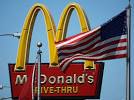 Amid a tumultuous past year for McDonald’s, the world’s biggest restaurant chain’s CEO Don Thompson is retiring after two years on the job, effective March 1. The fast food is also getting a new CFO.
Amid a tumultuous past year for McDonald’s, the world’s biggest restaurant chain’s CEO Don Thompson is retiring after two years on the job, effective March 1. The fast food is also getting a new CFO.
The restaurant’s Senior Executive Vice President and Chief Brand Officer Steve Easterbrook will replace Thompson, who is a 25-year veteran of the company, the company announced on Wednesday.
Previously, Easterbrook served as president of McDonald’s Europe and led the chain’s “efforts to elevate its marketing, advance menu innovation, and create an infrastructure for its digital initiatives,” it said in a release. The company’s CFO Pete Bensen will also transition to the role of chief administrative officer while Kevin Ozan, the company’s current corporate controller, will become the chain’s new CFO.
On Friday, the company delivered its latest update on its continuing U.S. turnaround, ongoing problems in Asia and the currency headwinds it faces.
Following the CEO departure news, the company’s stock ticked up 3 percent.
As McDonald’s continues its turnaround effort, Bill Smead, CEO and chief investment officer of Smead Capital Management, said he’d like to see the company take more risks and focus more on what customers want. The firm is a long-term shareholder in the company with about 180,000 shares
“Trying to please everybody is one of the issues that they’re dealing with,” he said in a phone interview. He also added he thinks the current low interest environment and McDonald’s high dividend yield has kept McDonald’s stock higher than it typically would be.
McDonald’s stock is nearly flat during Thompson’s tenure as CEO, compared to a 33 percent surge in the Dow and a 47 percent jump in the S&P 500.
In fiscal year 2014, global comparable sales growth, a key restaurant industry metric, dropped 1 percent, and its U.S. unit delivered a 2.1 percent decrease in comps. In fiscal year 2013, global comparable sales growth, a key restaurant industry metric, rose just 0.2 percent.
To turn around the U.S. unit, the company is shelving some menu items to reduce complexity, creating a build-your-own sandwich platform and focusing its advertising its efforts on stressing the quality of its food to consumers. It’s also doubling down on its digital efforts as restaurant technology becomes an increasingly large focus in the industry.
In China and Japan, the chain has faced continued fallout after one of its suppliers became the center of a food safety scandal in mid-July.
A stronger dollar has also hampered its profits since its sales in currencies that have fallen like the euro are worth less in U.S. dollars.
Ahead of the CEO departure, Wall Street has been cautious on the company’s stock with only six giving it either a “buy” or “overweight” rating, according to FactSet.
Leave a Reply
You must be logged in to post a comment.